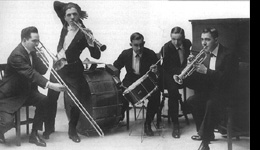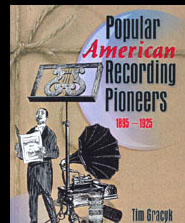 By Tim Gracyk
By Tim Gracyk
from the book "Popular American Recording Pioneers 1895 -1925." If you would like to order a copy of this book, click here for details.
By 1917 Earl Fuller led a society dance band at the popular Rector's Restaurant in New York City called Earl Fuller's Rector Novelty Orchestra. Their records released on Victor, Columbia, Emerson and Edison sold well from 1918 to 1920. Fuller ensembles helped popularize dance band trends of that period.
 For several of his earliest sessions Fuller led a small jazz ensemble
dubbed on record labels Earl Fuller's Famous Jazz Band, which was probably
formed at the suggestion of Victor executives eager to duplicate the success
of the first disc of the Original Dixieland Jass Band, made in late
February of 1917. Because of various grievances, the Original Dixieland Jass Band severed ties with
Victor for a year after making its first record, instead cutting titles for
Columbia and the new Aeolian- Vocalion label. Fuller's hastily assembled
jazz group filled the void, enabling Victor later in 1917 to meet a sudden
demand for jazz music. For several of his earliest sessions Fuller led a small jazz ensemble
dubbed on record labels Earl Fuller's Famous Jazz Band, which was probably
formed at the suggestion of Victor executives eager to duplicate the success
of the first disc of the Original Dixieland Jass Band, made in late
February of 1917. Because of various grievances, the Original Dixieland Jass Band severed ties with
Victor for a year after making its first record, instead cutting titles for
Columbia and the new Aeolian- Vocalion label. Fuller's hastily assembled
jazz group filled the void, enabling Victor later in 1917 to meet a sudden
demand for jazz music.
Earl Fuller's Famous Jazz Band included Walter Kahn on cornet, Harry
Raderman on trombone, Ted Lewis on clarinet, and John Lucas on drums. This
was the nucleus of the dance orchestra later led by Ted Lewis. Before
Fuller's first session, Lewis had been playing with Arthur Stone's
Syncopated Orchestra. In the early 1920s, the popular Ted Lewis orchestra
consisted of these four musicians in addition to cornetist David Klein,
trombonist Frank Lhotak, tuba player Harry Barth, and pianist Frank Ross.
This is reported on page 21 of the October 1923 issue of Musical Truth,
which was the trade journal for the maker of Conn instruments.
Photographs on sheet music suggest Fuller played piano on these dates
though Ernie Cutting may have been the pianist on records (as on other jazz
records of the period, piano on Fuller discs is the least audible of the
instruments). It was one of the first bands to imitate the Original Dixieland Jass Band though the
Frisco Jazz Band made an Edison recording on May 10, 1917, a little earlier
than Fuller's jazz ensemble.
"Slippery Hank" and "Yah-De-Dah," cut during the group's first session on
June 4, 1917, were issued on Victor 18321 in September 1917. These jazz
performances are notably loud, and the musicians use instruments for comic
effects. Victor's September 1917 supplement states, "A terrific wail from
the trombone starts 'Slippery Hank' (F.H. Losey) on his glide, and the rest
of the Jazz Band noises are in kind. And if you think these are all the
noises available for a Jazz Band, turn the record over and listen to
'Yah-De-Dah' (Mel. B. Kaufman). The sounds as of a dog in his dying anguish
are from Ted Lewis' clarinet. Notice the two little chords at the end of
each number. This is how you know for certain that a Jazz Band is playing."
Ending records with these "two little chords" had been introduced by the
Original Dixieland Jass Band.
His jazz discs sold well, especially "The Old Grey Mare" backed with "Beale
Street Blues" (Victor 18369), and, on Victor 18394, "Coon Band Contest" (a
rag composed by trombonist Arthur Pryor and recorded by banjoist Vess L.
Ossman as well as Sousa's Band as early as 1900) backed with "Li'l Liza
Jane," written by Countess Ada de Lachau and arranged by J.L. Burbeck.
Historian and critic Gunther Schuller expresses mixed feelings about the
band in Early Jazz (Oxford University Press, 1968), writing on page 184,
"The band's ricky-tick rhythms and cornetist Walter Kahn are very hard to
take today. Moreover, its performances are structurally monotonous in their
exact repetitions. Nevertheless, the band had a crude sort of
excitement..." The now- forgotten discs helped define and popularize a new
music, jazz, influencing young people who would later, in the 1920s, make
important recordings.
In 1918 Earl Fuller's Famous Jazz Band recorded for Edison several numbers
with titles that refer to the new music, including "Jazzbo Jazz" and
"Jazzin' Around." The August 1918 issue of Edison Amberola Monthly
characterizes "Jazbo Jazz One-Step" on Blue Amberol 3554 as "a real, red-
hot jazz dance of the most ultra modern variety," and this may be the first
time that a jazz record is promoted as "hot." The jacket for Diamond Disc
50541, featuring Fuller's own composition "Jazz de Luxe," states that the
band "was organized just at the time the jazz music became popular in New
York, and through its playing of jazz music in Rector's Restaurant, New York
City, Earl Fuller's Band became famous." Promotional literature for the
same number on Blue Amberol 3610 states, "Until you have heard one of Earl
Fuller's 'symphonies in rhythm' you are a novice in the art of appreciating
Jazz."
If you would like to order a copy of "Popular American Recording Pioneers 1895 -1925" click here for details.
Thanks to Al Simmons and Dominic Combe for their help with the recording on this page.
|
